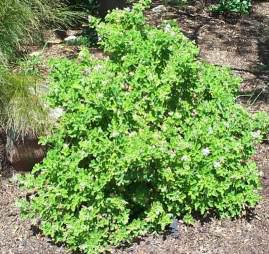Pelargonium graveolens
Pelargonium graveolens L'Heritier
Family: Geraniaceae
Common names: Rose-scented pelargonium, wildemalva
Introduction
Pelargonium graveolens with its attractive, strongly rose-scented leaves and pinkish white flowers is an interesting addition to the mixed border, adding texture, fragrance and colour.

Description
Description
Pelargonium graveolens is an erect, much-branched shrub, that can reach a height of up to 1.3 m and a spread of 1 m. The hairy stems are herbaceous when young, becoming woody with age. The deeply incised leaves are velvety and soft to the touch due to the presence of numerous glandular hairs. The leaves are strongly rose-scented. The showy white to pinkish flowers are borne in an umbel-like inflorescence and are present from late winter to summer (August - January) peaking in spring (September - October).

Distribution and habitat
Distribution description
This plant is confined to two separate areas in southern Africa, one in Limpopo Province, where it receives summer rain, and the other in the south-eastern part of the Western Cape, where it receives rain throughout the year. In both these regions, the summer is hot and the winter is mild, and Pelargonium graveolens is found growing on the mountains, in sheltered positions such as kloofs, usually in relatively moist habitats. Pelargonium graveolens has also been recorded in Zimbabwe and Mozambique.
Derivation of name and historical aspects
History
The genus Pelargonium gets is name from the resemblance of the shape of the fruit to the beak of a stork, pelargos in Greek. The species name graveolens refers to the strong fragrance of the leaves, graveolens meaning strong-smelling in Latin.
The genus belongs to the family Geraniaceae, which also comprises four other genera, Geranium, Erodium, Monsonia and Sarcocaulon. There are ± 220 species within the genus Pelargonium, and 80% of them are confined to southern Africa and about 80% of these are confined to the south-western corner of the country.
Uses
Use
Pelargonium graveolens is used in the production of geranium oil, which is used as a substitute for the expensive attar of roses in the perfume trade. Cultivars and hybrids of this species are grown commercially on the island of Reunion and elsewhere.
Growing Pelargonium graveolens
Grow
Pelargonium graveolens grows very well in moist, semi-shaded positions in the garden where it can be used as filler. Its velvety leaves add texture to the planting. This species also makes a good container or hanging basket subject, provided it is kept in a semi shade position. Pelargonium graveolens responds well to feeding with liquid organic fertilizers. Use a suitable systemic insecticide if whiteflies are observed feeding on the plants.
This plant can be propagated by means of stem and tip cuttings, or seed. Cuttings root well when dipped into a suitable rooting hormone and then placed in trays filled with coarse river sand. The trays should be kept in coldframes. Optimum rooting time is autumn (March - May) and spring (September - November). Seed can be sown in spring, summer or autumn.
Credits
Ebrahim Lawrence
Kirstenbosch National Botanical Garden
November 2002
Plant Attributes:
Plant Type: Shrub
SA Distribution: Eastern Cape, Limpopo, Mpumalanga
Soil type: Sandy, Loam
Flowering season: Spring, Early Summer, Winter
PH: Neutral
Flower colour: White, Pink
Aspect: Morning Sun (Semi Shade), Afternoon Sun (Semi Shade)
Gardening skill: Easy
Special Features:
Horticultural zones









Rate this article
Article well written and informative
Rate this plant
Is this an interesting plant?
Login to add your Comment
Back to topNot registered yet? Click here to register.